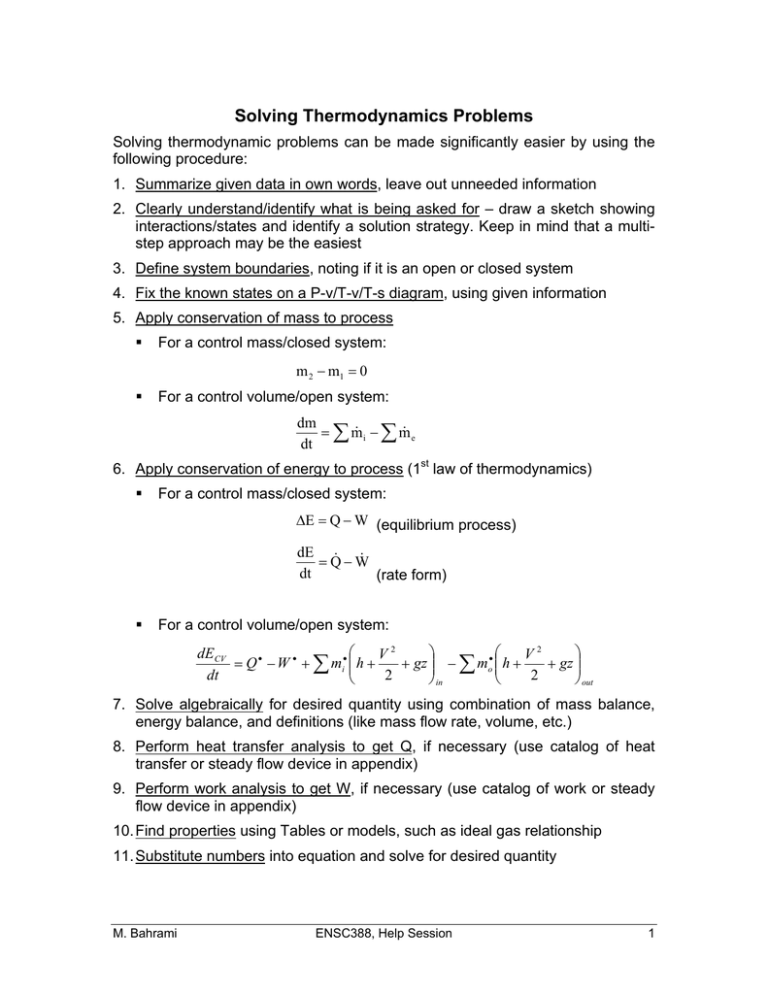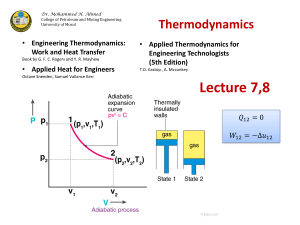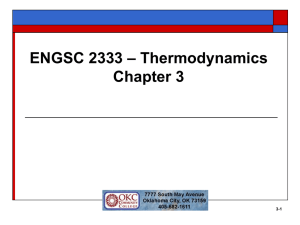Thermodynamics Problem Solving Guide
advertisement

Solving Thermodynamics Problems Solving thermodynamic problems can be made significantly easier by using the following procedure: 1. Summarize given data in own words, leave out unneeded information 2. Clearly understand/identify what is being asked for – draw a sketch showing interactions/states and identify a solution strategy. Keep in mind that a multistep approach may be the easiest 3. Define system boundaries, noting if it is an open or closed system 4. Fix the known states on a P-v/T-v/T-s diagram, using given information 5. Apply conservation of mass to process For a control mass/closed system: m 2 m1 0 For a control volume/open system: dm i m e m dt 6. Apply conservation of energy to process (1st law of thermodynamics) For a control mass/closed system: E Q W (equilibrium process) dE QW dt (rate form) For a control volume/open system: dE CV V2 V2 gz Q W mi h gz mo h 2 2 dt out in 7. Solve algebraically for desired quantity using combination of mass balance, energy balance, and definitions (like mass flow rate, volume, etc.) 8. Perform heat transfer analysis to get Q, if necessary (use catalog of heat transfer or steady flow device in appendix) 9. Perform work analysis to get W, if necessary (use catalog of work or steady flow device in appendix) 10. Find properties using Tables or models, such as ideal gas relationship 11. Substitute numbers into equation and solve for desired quantity M. Bahrami ENSC388, Help Session 1 12. Sanity check magnitude of answer and direction (if any) to see if the solution “makes sense”. Appendix This appendix contains a series of Tables for common parameters that are needed in solving thermodynamics problems. The user should consult the Cengel book details. Heat Transfer Heat Transfer Mode Equation Conduction (Fourier’s Law) kA dT Q dx Q hA Twall Tambient F A T 4 T 4 Q Convection (Newton’s Law) Radiation 1 2 1 2 Work Work Mode Equation Electric W VIt Spring W Expansion/Compression W PdV 1 k x 22 x12 2 Steady Flow Devices Device Conversion Process Nozzle Diffuser Turbine Compressor Pump Throttle Device Heat Exchanger Transfer streams M. Bahrami Typical Assumptions Flow energy(T, P) to KE KE to flow energy (T, P) Flow energy (T, P) to work Work to flow energy (T, P) Work to flow energy (P) Relieve pressure heat between S.S., adiabatic, no work, PE = 0 S.S, adiabatic, KE PE 0 S.S., adiabatic, no work, KE PE 0 flow S.S., no work, KE PE 0, external surfaces adiabatic ENSC388, Help Session 2 Substance Models Substance Model Application Domain Property Tables – solid, Whenever liquid, vapor experimental data is available for substance of interest Incompressible – liquid Most liquids and processes where volume expansion is not of interest Characteristics Real data, thus it is ideal as long as the experimental conditions used to make table are broadly applicable to the problem. Properties are approximated by the saturated liquid properties at the system temperature. Specific heats are temperature dependent only. Cp = Cv = C & du = CdT = f(T) y yf(T) h hf(T) + vf(T)*[P – Psat(T)] Incompressible – solid Most solids and processes where volume expansion is not of interest Compressibility Chart - Vapors that cannot vapor be classified as an ideal gas Ideal Gas M. Bahrami Specific heats are temperature dependent only. Cp = Cv = C & du = CdT = f(T) Assumes that the vapors of all substances are qualitatively similar, relative to their critical state. Scaling relative to the critical state allows the generalized compressibility chart to be used to find relation between P-v-T. Z = P v / RT PR = P / Pcrit and TR = T / Tcrit Special case vapor Allows use of ideal gas where PR (P/Pcrit) is equation of state, PV = m R T. nearly 0. Also, specific heats are only temperature dependent, therefore, energies are also only functions of temperature du = Cv dT = f(T) dh = Cp dT = f(T) ENSC388, Help Session 3







